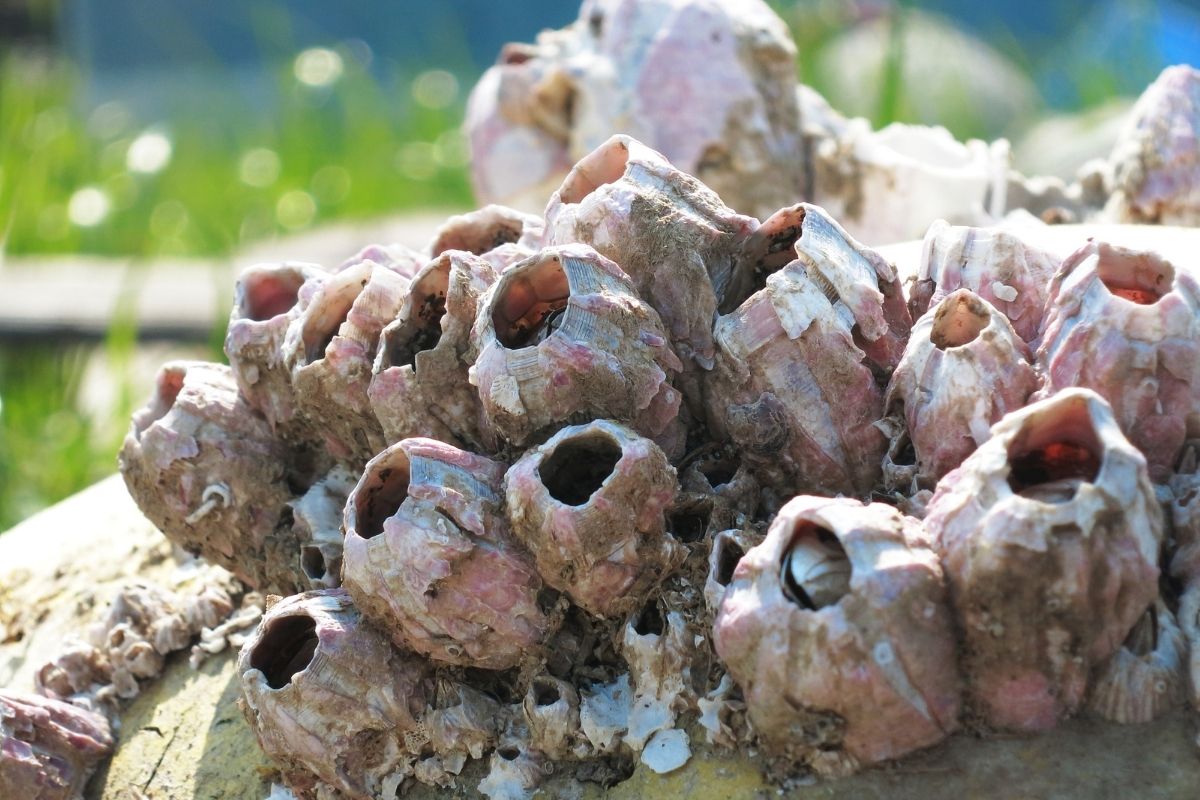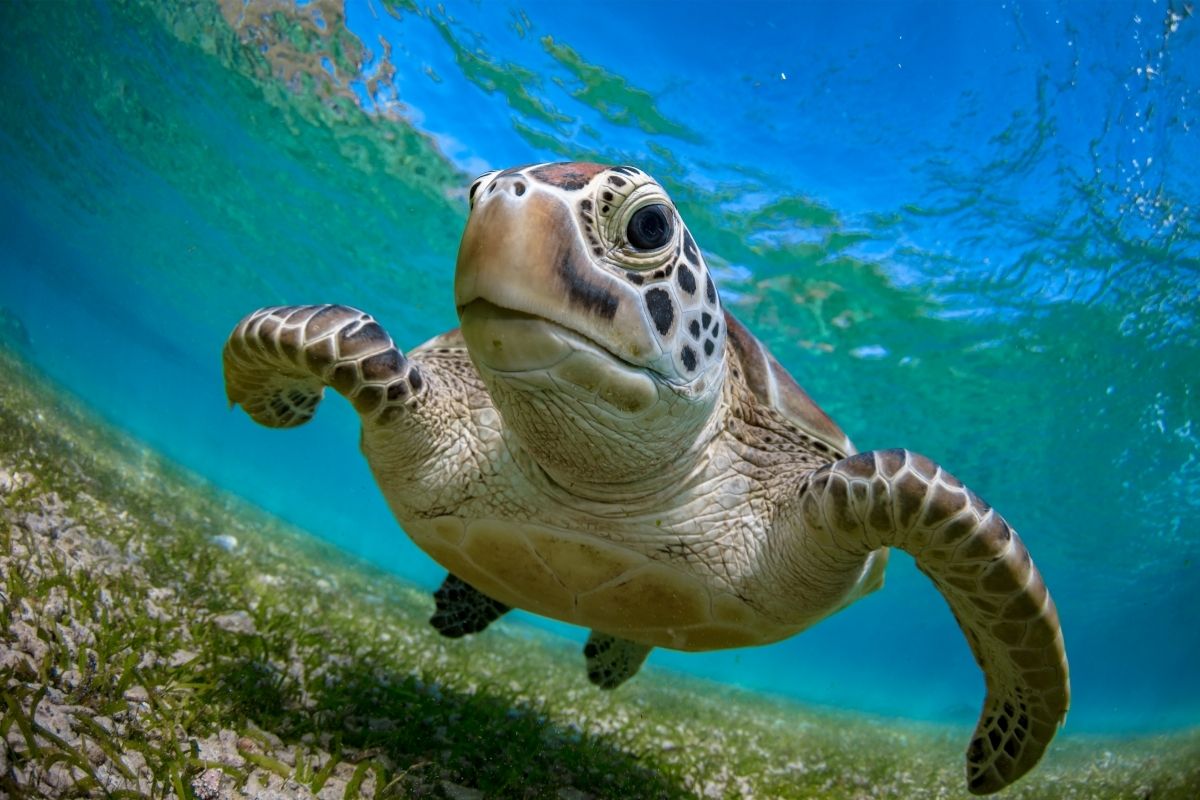Everyone loves sea turtles! They are cute, they are intelligent, and they have a great sense of humor. Turtles are found in many different habitats around the world, but the sea is the only place where with turtles, you are also likely to find barnacles!
Barnacles on turtles are actually a very common part of turtle life. Most people know this fact, but their knowledge stops there, and they are left wondering exactly why barnacles attach themselves to turtles, if they are harmful to turtles, and if they can be removed.
Luckily, we are here to help answer all of your barnacle-turtle-related questions in this article, so read on for more!

What Are Barnacles?
A barnacle is a small crustacean closely related to shrimp and crabs. They are sticky and like to live on hard surfaces – including anything from rocks, pilings, boat hulls, and turtles!
Barnacles are a whitish-grey color and sensitive to certain types of weather, such as dry or cold weather.
To feed, barnacles will pull at food in the water by using their legs, which ensures they thrive in moving and marine waters. Adult barnacles will feed on debris and plankton; they are filter feeders.
Why Do Barnacles Attach Themselves To Turtles?
Barnacles cannot survive in the sea without a hard surface to thrive on. When barnacles are in their larvae stage, they will attach themselves to rigid substances and hard surfaces.
Additionally, barnacles need constant water movement, so they try to settle on moving substrates, which is where turtles come into the picture.
If a turtle gets too close to a barnacle, the barnacle will attach itself to the turtle’s shell – a hard surface. They are able to do this because they secrete a substance that allows them to stick to hard surfaces.
Do Barnacles Harm Turtles?
Generally, no. A barnacle will not harm a turtle if it becomes attached to it. However, if there is a huge cluster – an infestation – of barnacles on a turtle’s shell, then this is not good.
In fact, if there is an excess amount of barnacles on a turtle’s shell, then this is a key sign pointing to bad health in the turtle.
Turtles are actually able to control the number of barnacles that become attached to them, and they will never exceed a certain number. If there are too many barnacles on the shell of a turtle, it is a sign that the turtle is in poor health.
Too many barnacles on a turtle’s shell are actually a sign of an inactive and slow turtle. This is made worse by the barnacles because they will also cause the turtle to move slower, as well as cause discomfort.
A slow turtle is a turtle who finds it difficult to search for food. And, if a slow turtle manages to find any food, it will find it difficult to catch because of its slowness.
Naturally, when a turtle is not eating enough food, it can grow sick and find moving more strenuous and difficult. The turtle will become exhausted a lot faster.
Additionally, barnacles may cause damage to a turtle’s vision if they attach themselves near the eye. Barnacles can also prevent turtles from eating if they attach themselves too close to their mouths.
Finally, barnacles can actually do a lot of harm to turtles if they are drilled into the shells’ carapace. This will cause infection to the turtle, such as abscesses, which can even lead to death.
Can Turtles Remove Barnacles?
No. Sea turtles do not have any real way of removing barnacles from their shells. Usually, barnacles will fall off naturally if scratched against something, like a rock. However, there are some ways they can and do try. Let’s look at some examples!
Using Their Flippers
Some sea turtles use their flippers to try and remove barnacles from their shells. They will grab onto the barnacle with their claws and then push against the barnacle until it detaches.
This method works best if the barnacle is small or has already partly broken off. It does work, but it takes time and energy.
The Mating Process
In the case of female sea turtles, barnacles will fall off their shells when they mate with male turtles because they will brush themselves against their male counterparts, which causes the barnacles to loosen and fall.
However, these methods of removing barnacles are not always useful, and most barnacles will need to be removed by a professional.
Are You Able To Remove Barnacles From Turtle Shells?
No. we strongly advise against trying to remove barnacles from the turtles yourself. This is because they are hard creatures, and removing them can be extremely painful for turtles.
The carapace and plastron of the turtle are very soft, so their shells can become damaged if you try and forcibly remove them.
Not only that, but when a barnacle is removed from a turtle shell, this leaves an open wound. This open wound needs to be treated with the correct medication at the proper time, or else it will become infected and cause even more pain to the turtle.
For these reasons, it is always better to seek out a professional to remove barnacles from turtle shells, such as those who work at a marine wildlife rehabilitation center.
In fact, in the United States, you need a permit to remove barnacles from turtle shells. If you try to remove barnacles without a permit, then you are committing harassment of a listed species.
This is considered to be a violation of the Endangered Species Act, which is a serious offense.
Luckily, you should have no cause for concern when you see barnacles attached to turtles. This is because specialists have the relevant experience to remove barnacles safely. Generally, they will follow these steps:
- To help ease the removal of the barnacles, the turtles will be placed in freshwater. This ensures no more barnacles will grow on their shells.
- Any existing algae should fall off within two to three days.
- The specialists will carry out additional blood tests to check for any other issues.
If all goes well, the turtles will recover within a few weeks and will eventually be released back into the sea.
Are Barnacles Helpful To Turtles?

While it seems like the barnacle species are more of a hindrance to turtles, did you know that they can actually be helpful? In some cases, barnacles can be lifesaving!
For example, barnacles can act as camouflage for sea turtles, which comes in handy when they come across sharks, poachers, and crabs – which often mistake them for rocks.
Barnacles also help scientists to study sea turtles. Through barnacles, scientists study how to better conserve sea turtles, as well as their migrations.
With barnacles, scientists can help map out the migration of turtles, which helps to detect the crucial conservation regions for specific endangered species of sea turtle.
Studying the migration of turtles is important because it has previously been difficult to track. This is because the migration of a sea turtle is one of the longest in the animal kingdom. Sea turtles will cross oceans to find their favorite beaches to nest on. Turtle-born barnacles help to solve this problem greatly.
Frequently Asked Questions
Do Barnacles Have Eyes?
Barnacles do not have eyes. However, they do have sensory organs called setae. These setae allow the barnacles to sense light, water currents, temperature changes, and vibrations.
How Long Does It Take For A Turtle To Recover From Barnacles?
The length of time depends on the size of the barnacle. Smaller barnacles take longer to heal than larger ones. Also, if the turtle was injured during the attachment process, then recovery times may vary.
What Are Some Ways To Prevent Pet Turtles From Getting Barnacles?
There are several ways to prevent turtles from getting barnacles. First, ensure your turtle pool or tank has a filter system. This prevents debris from entering the tank, which could lead to barnacles growing on the shell.
Secondly, keep an eye out for any signs of algae growth on the shell. This could mean there is too much salt in the water, so ensure you change the water every week.
Finally, make sure your turtle is fed properly. Make sure they get enough protein, calcium, vitamins, and minerals. All of these things are essential for the general health of a turtle.
Is There Anything Else I Should Know About Barnacles?
Yes, there is something else you need to know about barnacles. If you notice any redness around the area where the barnacle attaches itself, then you should contact specialists to remove the barnacle immediately.
This will reduce the risk of infection.
Final Thoughts
Barnacles are part of the crustacean family that likes to attach to hard surfaces when they’re in their larvae stage. One of these hard surfaces is turtle shells.
Generally, barnacle larvae are not harmful to turtles and can actually be quite helpful for turtle camouflage and the study of them.
However, excessive barnacles can cause issues such as sluggishness, starvation, exhaustion, infection, and in extreme cases, death.
If you see a sea turtle with excessive barnacle cover, it is important not to try and remove them yourself. This can cause great harm to sea turtles. It can damage their shells and cause infection if their open wounds are not properly treated.
Excessive barnacles are best removed by properly trained specialists who will ensure the turtle’s full recovery. Then, the happy and healthy turtle will be released once more into the sea.
